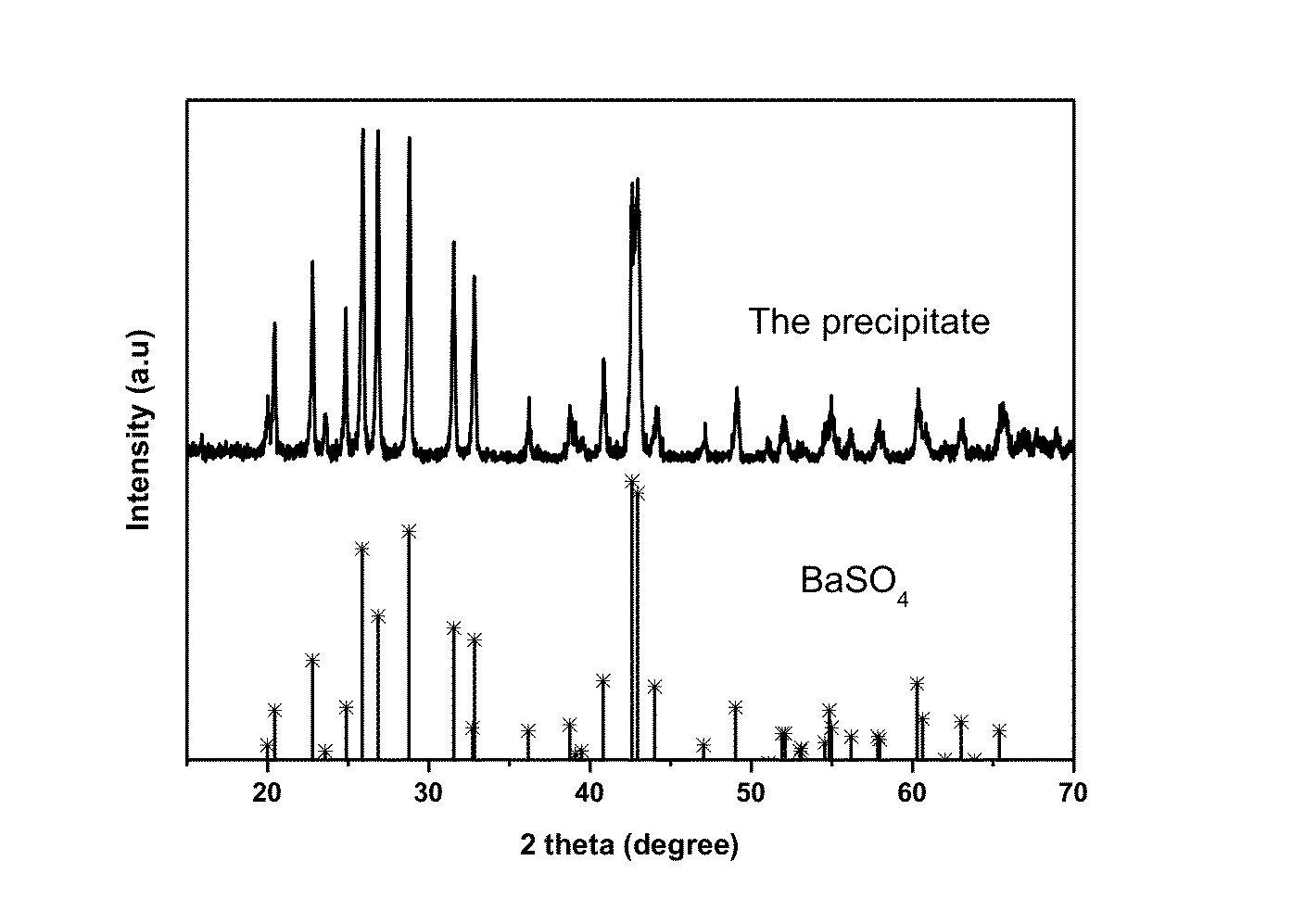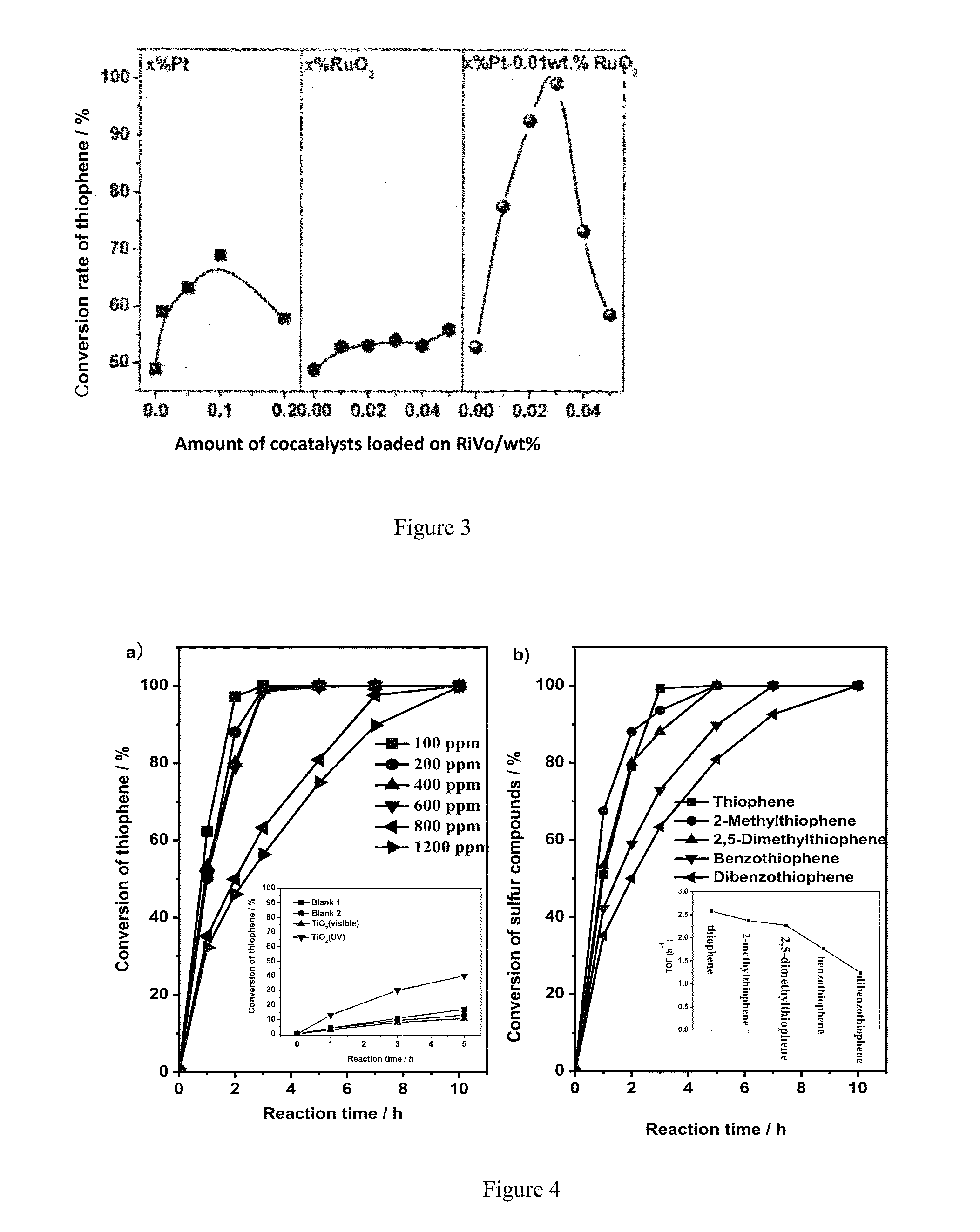Visible light catalyst for removing sulfur-containing compounds in fuel oil, and preparation and use
a technology of sulfur-containing compounds and visible light, which is applied in the direction of metal/metal-oxide/metal-hydroxide catalysts, physical/chemical process catalysts, metal/metal-oxide/metal-hydroxide catalysts, etc., can solve the problems of high operating cost, difficult removal of sulfur-containing compounds in fuels, especially gasoline, and acid rain, so as to avoid the oil's absorption of light, reduce operating cost, and reduce the effect of cos
- Summary
- Abstract
- Description
- Claims
- Application Information
AI Technical Summary
Benefits of technology
Problems solved by technology
Method used
Image
Examples
example 1
[0033]Preparation of BiVO4 in the Invention
[0034]Adding bismuth salt and vanadic salt (the mol ratio of the bismuth salt and vanadic salt is 1:1 into 2 M HNO3 (aq) to form a solution with the bismuth and vanadic concentration of 0.1 mol L−1, the pH value of the reaction mixture was adjusted to 2.2 with ammonia solution under vigorous stirring. After stirring, the reaction mixture was transferred into a Teflon-lined stainless steel autoclave, and aged at 200° C. for 24 h. Filtration and washing with plenty amount of water afforded vivid yellow powder, which was dried at 90° C. overnight.[0035]The use of BiVO4 as prepared is in the photocatalytic oxidation desulphurization reaction:[0036](1) adding 50 mg photocatalyst A into 50 mL solution contained thiophene(the concentration of sulfur is 600 ppm) with O2 bubbled in, wherein the temperature is 10° C., reaction under vigorous stirring for 180 min with visible light irradiation under atmospheric pressure conditions.[0037](2) Separated ...
example 2
[0038]Preparation of the catalyst in the invention is as follows:
[0039]Iridium trichloride (0.050 g) was weighed and dissolved in 100 mL water to form a solution. The solution was continuously stirred for 30 min. 1.0 g BiVO4 as prepared in example 1 was added into 5 mL solution above with ultrasonic treatment 1 h, after subsiding for 24 h the water present in the solution was vapored at 50° C. under vigorous stirring, and then calcined at 300° C. for 1 h to form the catalyst precursor. Added the catalyst precursor into the mixture solution of distilled water and methanol (V water:V methanol is 4:1) to form the suspension. Then added 1 mL chloroplatinic acid (the concentration is 0.3578 mg Pt mL−1) into the suspension under vigorous stirring. The suspension was irradiated for 1 h with N2 (≧99.9%) bubbled in. After filtration, washing and vacuum drying the vivid yellow powder catalyst was obtained, the vivid yellow powder catalyst prepared in this example was denoted as Cat-A.
example 3
[0040]The catalyst denoted as Cat-B was prepared by the same method as Example 2 except that 0.420 g ruthenium trichloride was used instead of 0.050 g iIridium trichloride used in Example 2 and only used 0.5 mL of the solution.
PUM
| Property | Measurement | Unit |
|---|---|---|
| temperature | aaaaa | aaaaa |
| temperature | aaaaa | aaaaa |
| temperature | aaaaa | aaaaa |
Abstract
Description
Claims
Application Information
 Login to View More
Login to View More - R&D
- Intellectual Property
- Life Sciences
- Materials
- Tech Scout
- Unparalleled Data Quality
- Higher Quality Content
- 60% Fewer Hallucinations
Browse by: Latest US Patents, China's latest patents, Technical Efficacy Thesaurus, Application Domain, Technology Topic, Popular Technical Reports.
© 2025 PatSnap. All rights reserved.Legal|Privacy policy|Modern Slavery Act Transparency Statement|Sitemap|About US| Contact US: help@patsnap.com



